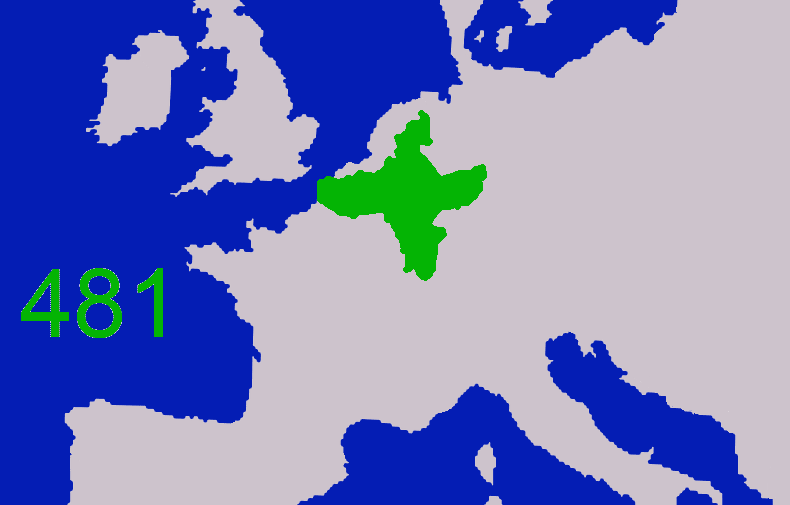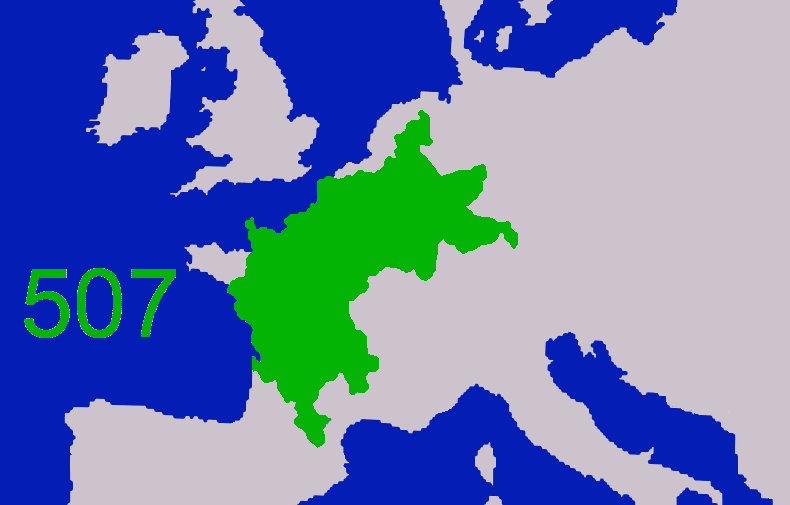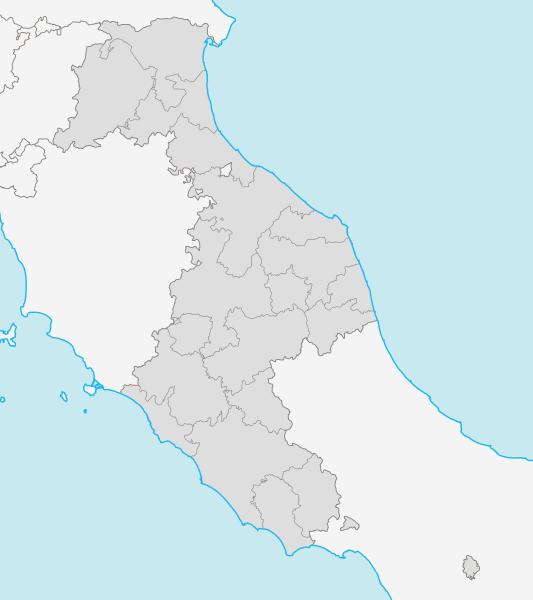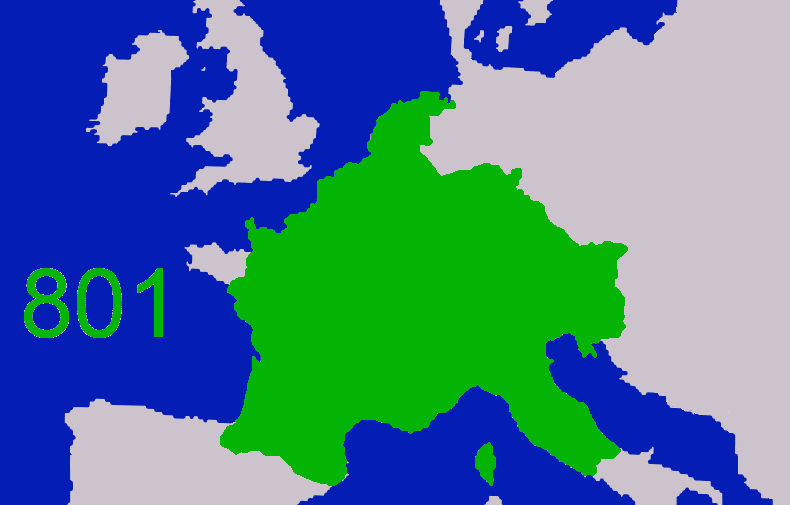When we look at the swirl of peoples, cultures, and languages that made up mainland Europe north of the Mediterranean Basin at the time of Pope Gregory the Great, we can pick out names that we recognize either plainly or vaguely, the progenitors of many of the European nation-states of today: the Angles, the Saxons, the Serbs, the Huns, the Bulgars, the Magyars, the Celts, the Poles. Christianity found fertile ground among these peoples. In places where most lives still tended to be nasty and short, where might often seemed the only right, the Christian promise of a better world waiting after this one was heady indeed. Christianity didn’t spread because it was forced upon the peoples of Europe, although this was attempted from time to time; it spread because it gave them consolation and hope, made them feel that there was meaning amidst the chaos of their lives.
For Pope Gregory, however, there was a towering caveat to this happy tale: the version of Christianity most of these peoples were accepting was the heretical one known as Arianism. This was to a large extent orthodox Christianity’s own fault. The Roman emperors had long dismissed the lands north of Italy as the home of the barbarians, to be exploited in the early centuries of the empire, to be feared in the later ones, but always to be seen as the savage, benighted Others. This attitude had not changed after Constantine made the Roman Empire a Christian one. The Arian sects who were being driven out of the civilized world were thus left free to settle and spread their version of the faith in these neglected hinterlands, as well as others well to the east and south of the empire’s heart.
Like many a Roman pope before him, Gregory believed that God had granted him authority that extended well beyond the gates of Rome. Yet he became only the second pope to succeed in exerting his claimed authority to any appreciable degree. He did so by allying himself to a non-Arian people known as the Franks, whose heartland lay around the city of Paris.
The Franks are emblematic of the febrile times in which they lived, when Europe was still very much in the process of sorting itself out; although they would later lend their name to the nation of France, the language they spoke had more in common with modern German. Like such other Germanic tribes as the Visigoths, the Vandals, and the Ostrogoths, the Franks had a hard-won reputation for being fierce and enthusiastic fighters. Yet they were destined to become known as the powerful friends of Rome rather than its despoilers.

The origin story for this state of affairs reaches back well before the time of Pope Gregory, to the turn of the sixth century. At that time, a Frankish warlord named Clovis became the first man to unite all of his people under his rule. He is still known to all French schoolchildren as the founding father of their nation. (Transcribed into French from the original Frankish with a Latin stop in between the two, Clovis’s name winds up as “Louis,” the name of no fewer than eighteen later French monarchs.) At the prompting of his queen, who was already a Christian, Clovis converted from paganism to that faith. And importantly, the Christianity he chose was not the Arian stripe but rather the orthodox version of the faith.
He went on to conquer a large swath of territory from his base around Paris, expanding eastward as far as the Rhineland of Germany and southward almost as far as modern France’s border with Spain. Like the Roman Emperor Constantine before him, Clovis credited his many battlefield victories to the direct intervention of Jesus Christ in support of his side. The kingdom of Francia which he left behind after his death in 511 ebbed and flowed and split in two for a while on at least one occasion, but never wavered in its staunch commitment to orthodox Christianity.

Eight decades after Clovis’s death, Pope Gregory sent missions to rejuvenate the orthodox faith throughout Europe. With the support of Francia, that firmest of all the existing orthodox enclaves in Europe, they ventured as far west as the islands of Britain and Ireland, where they were largely successful in their conversion efforts, and as far north as the windy wildernesses of Scandinavia, where they were largely rebuffed for now.
Gregory was no mindless zealot; he could be pragmatic and diplomatic when the situation called for it. Like Pope Leo before him, he saved Rome itself from being sacked at least once, by negotiating an accord with an Arian people called the Lombards who threatened it. Gregory’s well-publicized charity and selflessness — he continued to live in Rome as he had in the monastery, dressing in coarse robes, eating only the most basic foods around the same crude table as his ostensible servants — caused him to be seen as a living saint even by those who did not consider themselves orthodox Christians, aiding the missionary cause immensely. The Arians had no comparable figure, and they paid the price for it.
Once it got serious about evangelizing on the mainland, the Roman Church found it had a second huge advantage over Arianism: the very fact that it was based in Rome. Much of the Church’s appeal stemmed from its overt Roman-ness: its orderly, ritualistic pomp and circumstance, and the language of Latin that it still clung to doggedly, even as that tongue was fast falling out of daily usage everywhere else, being supplanted by other, purportedly cruder languages, more symbols of a fallen age. “Everyone wanted to be Roman,” writes Diarmond MacCulloch. “The memory of the empire stood for wealth, wine, central heating, and filing systems.” A religion that promised its adherents a glorious future eternal life became inextricably associated with nostalgic reminiscences of a better world that had already passed away — this despite the fact that it had been a Roman governor who had crucified Jesus, a Roman emperor who had martyred Saint Peter, and a Roman Empire that had, according to Church accounts, relentlessly persecuted and slaughtered Christians for the first 250 years and more of their religion’s existence. If history teaches us anything, it is that humanity has enormous capacity for cognitive dissonance.
By popular demand, the leader of one European kingdom after another switched his allegiance to the theology of Rome. Had things gone just slightly differently, Western Christianity as a whole might very well be Arian Christianity today. As it was, though, Arianism was fated to slowly die away, doomed by the energy, cleverness, and charisma of Pope Gregory. The importance of what he set in motion belies the fact that he was pope for only thirteen and a half years, from September of 590 until his death in March of 604.
By that time, Christianity as a whole was waking up to an external danger that was far more daunting than any of its internecine squabbles. The Christian lands on the southern shores of the Mediterranean were starting to fall one by one to the missionary and martial zeal of Islam, a new monotheistic religion that borrowed much from Christianity but also embraced the teachings of Mohammad, a more recent prophet than Jesus Christ. The Byzantine Empire was hard-pressed; in 636, Muslim Arabs wrested away from it Palestine and its capital of Jerusalem, respectively the homeland of Jesus and the city where he had been crucified. Egypt fell in 642, and with it went Alexandria, the very city where Christianity had been molded into a coherent religion. By the early eighth century, the Muslim caliphates seemed like an unstoppable force of nature, having taken over even Europe’s Iberian Peninsula.
Their next logical target was obvious: in 732, a Muslim army struck northward toward the heart of Western Europe. There it met a Frankish army, in a clash that has gone down in history as the Battle of Tours. True to their reputation for martial prowess, the Franks threw back the Muslims, providing a novel experience for a religion that had known little but victory on the battlefield to date. With the Battle of Tours, the period of terrifyingly swift Muslim expansion ended, the two faiths settling into an uneasy stalemate that would persist for centuries. Christians were thus free to fight among themselves again.
In 751, an ambitious Frankish general named Pepin packed his king off to live in a monastery and took over the kingdom of Francia himself. Needing to justify his actions, he turned to God — or rather to God’s self-proclaimed holy representative here on Earth. He wrote a letter to the current Pope Zachary in Rome, making his case for the necessity of his rebellion and asking for the Church’s sanction. The pope granted it: “He decreed that Pepin should be made king,” as the official record says. The significance of this direct intervention in the political affairs of a European kingdom can hardly be overstated. “The stage was set for kings to begin to regard themselves as in direct contact with God: approved and protected by the Almighty and entitled to think of themselves as his deputies on Earth,” writes Dan Jones in his history of the Middle Ages. “And at the same time, the Church had been granted the right to judge the performance of kings. The implications of this pact would be felt long into — and indeed, after — the Middle Ages.” In the shorter term, the alliance between Francia and Rome was about to transform the map of Europe.
Over the next seventeen years, King Pepin III, as he became known, expanded Frankish territory aggressively and effectively. He acceded to Pope Stephen II’s request that he drive out of Italy the Lombards, who had been intermittently troubling Rome since the time of Gregory the Great. That feat accomplished, Pepin gave the Church an extraordinary gift in 756: he “donated” to it most of the Lombard lands, a seahorse-shaped ribbon of territory stretching from somewhat south of Rome on Italy’s west coast, obliquely across the peninsula, and then along the east coast almost as far north as Bologna. The political entity thus created became known as the Papal States, and would persist under that name for some 1200 years. The pope was now the leader of a country all his own, one of considerable wealth, with an army of its own and all the other trimmings of national sovereignty. The Church had come a long, long way from the original Christian ethic of holding the divine and the temporal separate, of giving Jesus his due whilst also obediently rendering unto Caesar that which was Caesar’s. Now, the pope was starting to bear a distinct resemblance to Caesar.

Around this time, an enormously important document emerged, allegedly out of the mists of the distant past. The Donation of Constantine is called by the Medievalist Johannes Fried, who has studied it extensively, “the most infamous forgery in the history of the world.” In the maximalist interpretation which the Church applied to it, it meant that “no criticism of the papacy or accusation against it was possible.” For more than half a millennium to come, this document would provide as crucial an argument for the Roman Church’s claim of supremacy over all of the others in Christendom as those two critical sentences in the Gospel of Matthew.
The Donation of Constantine purports to be a letter written by the titular first Christian emperor of Rome to Pope Sylvester I. In it, Constantine praises the pope and the Church effusively for giving him spiritual salvation, for curing him of leprosy, and for helping him to win many battles. By way of recompense, he makes a “donation”: “The pope shall have supremacy over Antioch, Alexandria, Constantinople, and Jerusalem, and all the churches of God in the whole world. The holy law shall rule where Saint Peter was martyred [i.e., shall rule from Rome]. Anyone who violates this shall be bound over to eternal damnation. And this imperial decree we confirm with our own hand and place over the body of Saint Peter, promising to preserve inviolably all its provisions.”
But why, you may be wondering, should the decree of a mere temporal emperor, dead almost 450 years already when his Donation first turned up, have carried so much weight? Once again, the answer is bound up in the intense nostalgia during the Middle Ages for those semi-mythical bygone days of Antiquity, when the world was so much richer, more orderly, and more cultured. In this milieu, the imprimatur of a figure like Constantine was worth more to the pope’s claim to complete spiritual dominion than the testimony of anyone short of Jesus himself or one of the other saints of the Bible. The romanticizing of Antiquity — the very word “romance” derives from “Rome” — gave the Donation of Constantine the force of veritable holy writ.
Given how convenient the document was for the Roman Church’s agenda, one wants immediately to assume that it must have been forged inside that same institution. Johannes Fried, however, strongly suspects after following a trail of linguistic clues that it rather came from Francia, one more result of the mutually beneficial alliance between the Franks and the popes. Other historians disagree.
But regardless of where it came from, the Church made quick use of the Donation of Constantine. Already in 778, Pope Hadrian could write to Charles I, Pepin’s successor as king of the Franks, that
Just as in the time of the Blessed Pope Sylvester, God’s holy, catholic, and apostolic church was raised up and exalted by and through the bounty of the most pious Constantine of holy memory, the great emperor, who deigned to bestow power upon it, so also in these most happy times in which you and we live, may the holy church of God — that is, of Saint Peter the Apostle — burgeon and exalt and continue ever more fully exalted, so that all peoples who hear of this may be able to proclaim, “Lord save the king! And hear us when we call upon you!” For behold, a new Constantine, God’s most Christian emperor, has arisen in these times.
This “new Constantine” Charles I, who had ascended to his throne following the death of his father Pepin in 768, would go on to assemble an empire the likes of which wouldn’t be seen again in mainland Europe until the time of Napoleon. He is more commonly known today as Charlemagne, French for “Charles the Great.” He is sometimes called the Father of Europe as well, but a better title might be the Father of the European Middle Ages as we think of them today, that time of kings, nobles, and peasants. For he instituted across his empire the Frankish hierarchy of power that we now call the feudal system, in which authority descended from the monarch himself down though the semi-independent but nevertheless troth-pledged noble landowners to the peasants who worked the fields.

By the year 799, Charlemagne’s empire encompassed most of modern France, Germany, Switzerland, Austria, Belgium, and the Netherlands, a small piece of northern Spain, and those parts of the northern half of Italy that didn’t belong to his close ally the Papal States. An astute politician by any standard, Charlemagne now cemented his hold on his empire with an appeal to those two potent, interconnected cultural currents: the Church in Rome, and the ongoing nostalgia for the Roman Empire of old.
At the time, Leo III, the present pope in Rome, was enduring less halcyon days. The heart of the holy Church had often been a viper’s nest of intrigue, and the temporal political power it had been accruing in recent years had done nothing to dampen the ardor of the intriguers. Leo had clawed his way into his office in 795 in the face of powerful enemies, who were not prepared to stop their plotting now that he was their religion’s holy man of holy men. On April 25, 799, he was seized while leading a procession to Mass. A Church history of Leo’s reign claims that his attackers stripped him naked and tried repeatedly to put out his eyes and cut out his tongue, only for his sight and his voice to be restored each time through a miracle of God. Be that as it may, the conspirators opted in the end for the same gambit which Charlemagne’s father had once employed to rid himself of a pesky ruler: they packed Leo off to a monastery to live out his days as pope in name only, able neither to claim the status of martyr nor to interfere with their own plans for the Church.
Leo, however, foiled their plot by escaping the monastery. He made his way to Paderborn, the German city where Charlemagne currently had his court. After some tense discussion, Charlemagne declared that he would travel personally to Rome to preside over a trial of Leo, at which both sides would be allowed to state their case — a judicial function to which he had no right other than that provided by the might of his army. It was more than enough; the trial sputtered to a close almost before it had gotten going, thanks to a lack of prosecution witnesses ready to speak truth or libel to the power of a monarch who clearly favored Leo. Leo’s former persecutors were condemned to death by Charlemagne, but the pope demonstrated his mercy by commuting their sentences to exile.
On Christmas Day, 800, Pope Leo III paid back his debt to his patron. He and Charlemagne stood together that morning beneath the flickering light and shadow of a thousand candles burning inside Saint Peter’s Basilica, the cathedral of Rome. Leo sprinkled Charlemagne’s brow with holy oil, picked up a magnificently jeweled crown, and placed it on his head. Then the pope knelt at the feet of the king while the parishioners around them gasped. “Hail to Charles the Augustus, crowned by God the great and peace-bringing emperor of the Romans!” he thundered. With these words, he made Charlemagne the first Holy Roman Emperor, uniting the glory of the Church with the nostalgic cachet of the empire of Antiquity. (“Augustus” had been the name of the very first Roman emperor, the same one who reigned at the time of Jesus’s birth.)
“The coronation was of great benefit to both sides,” write the historian of the papacy Richard P. McBrien. This is a decided understatement. The pope’s stamp of approval established a legal and philosophical basis for an empire that had heretofore been a credit to Charlemagne’s military prowess alone, allowing him to look upon the Byzantine emperor to the east as a peer, or perhaps even as his junior; his own empire was by now much larger than the Byzantine one, which had been sadly diminished by the inroads made by Islam. At the same time, the crowning rejuvenated a theory of governmental legitimacy which dated back to the earliest pharaohs of ancient Egypt if not before, one to which Leo had now given the Church’s unequivocal sanction: the theory that monarchs were chosen and favored by God himself, meaning that to rebel against them was literally to defy God. I trust that the implications for realpolitik require no elaboration.
Meanwhile Leo had indissolubly tied the fate of the Church to a man who would prove the most powerful single monarch of the entire Middle Ages. Unfortunately, the pope had sacrificed a fair measure of his independence if not his dignity to bring it off. In the years that followed, Charlemagne, an inveterate reformer with ideas about just about everything, inserted himself repeatedly into the internal workings of the Church, promoting favored candidates for various Church offices, even convening councils on thorny theological questions and lobbying for changes to the hallowed Nicene Creed, orthodox Christianity’s most fundamental statement of faith. Leo’s surviving letters to Charlemagne, begging for help with this or that petty problem, make it all too clear who was the weaker partner in the relationship, even if Leo does still deign to affect the royal “we.”
Charlemagne died in 814, Leo two years later. But the Holy Roman Empire they had concocted between them would persist for another 1000 years, passing through many different hands and lineages, the boundaries of its territory shifting constantly.
In its early heyday, this self-conscious echo of the past began the slow process of lifting Western Europe out of the hardscrabble chaos of the past few centuries and awakening in it a sense of its potential. In Aachen, a city near the center of Charlemagne’s empire that served as the closest thing this peripatetic monarch had to a permanent capital, he set up a publishing hub of sorts, filling scriptoriums with hundreds of scribes who busily copied documents of many types for the benefit of their posterity. “We must not overestimate the intellectual quality of the age,” cautions Will Durant. “This scholastic resurrection was the awakening of children rather than the maturity of such cultures as then existed in Constantinople, Baghdad, and Cordova.” Charlemagne himself might be seen as a symbol of his empire’s state of intellectual development; he tried earnestly to learn to write as well as he could read in his latter years, but never quite succeeded. Nevertheless, he set Europe on the long road to recovering the heritage of Antiquity, a road whose final destination lay still more than half a millennium in the future at the time of his death.
Charlemagne’s reign also gave to Europe the epic hero Roland, a brave and steadfast knight who fought with the emperor’s armies, and at the last bravely died in his service. On the one hand, Roland was the first glimmer of a new literature and ethic of chivalry that weren’t to fully dawn for a few hundred years yet. On the other, he was a mythical hero for the new age that could stand comfortably alongside the likes of Achilles, Odysseus, and Aeneas. Indeed, Roland’s exploits were typically sung aloud to the illiterate common people, just as Homer had once done it.
And yet, crucially, Roland was a Christian hero, chaste and true. Like the institution of the Holy Roman Empire itself, he thus tied together two previously disparate threads. And then too, he signified a Church that was coming around to the idea that an armed soldier of God might be worth just as much as a peaceful martyr to his religion — or perhaps even more.
Did you enjoy this chapter? If so, please think about pitching in to help me make many more like it. You can pledge any amount you like.
(A full listing of print and online sources used will follow the final article in this series.)


Michael Russo
Another enjoyable entry! For whatever reason, just now (after all these articles) am I remembering how I used to love reading Isaac Asimov’s series of histories when I was a teenager, and how your really remind me a lot of that time, just learning history in a fun and interesting fashion.
Andrew McCarthy
Magyrs > Magyars
Another excellent article!
Jimmy Maher
Thanks!
Tim Kaiser
By the early eight century > By the early eighth century
andreas
“He instituted across his empire the Frankish hierarchy of power that we now call the feudal system, in which authority descended from the monarch himself down though the semi-independent but nevertheless troth-pledged noble landowners to the peasants who worked the fields. It may have left much to be desired from a modern social-justice perspective, but, in bringing a modicum of legal and economic organization back into the world, it left just about everyone better off and more secure than they had been before.”
It is commendable that you write this honestly – this way of thinking is often implicit in historiography.
Of course this sentiment is pure ideology, goes against all the historical evidence and falls apart on a cursory look.
Btw this has little to do with “modern social-justice perspective” – which again belittles the people in the Middle Ages. If anything, people living back then had more experience with different social systems as well as the agency to choose for themselves. As the military reach of the centers of power like Charlemagne’s court was quite limited over many people living in those borders shown on those maps (there literally were no borders back then ;-). Certainly most people were free to do as they pleased for much of the time as roads were impassable to soldiers and tax collectors in the winter, etc. The Dark Ages weren’t necessarily all that dark, only from the perspectives of those with the power to employ scribes who do not grow their own food, weave their own clothes, etc. It is pure prejudice to simply assume that people were better off in a system that had to marshal systematic violence to quell “peasant uprisings” quite like the slave states during the preceding “golden” ages.
It is also quite weird to suggest this in a chapter that is about different religious organizations promoting diverse ways of living. The endless religious strife in Europe itself shows that the outcome was far from clear at the time and that history could just as well have fallen out rather differently as noted in the chapter itself multiple times.
There is no shortage of modern historical and anthropological research showing a much more interesting picture of diverse social orders people being actively pursued, for those interested I’d recommend James Scott’s as well as especially David Graeber and David Wengrew’s recent work.
Jimmy Maher
Point taken, more or less. 😉 I’ve excised some of that, which overreached and didn’t really need to be there. Thanks!
Peter Olausson
I like the construction “faint accompli” so much I hesitate to point it out. 😉 And regarding the constantine donation, what about “the city of Rome, and all the provinces, places and cities of Italy and the western regions”?
Splendid text, as always.
Jimmy Maher
🙂 Thanks! I did try to cut the Donation down to the gist of the thing as it would be applied in later centuries, when the pope’s authority over Rome and its immediate neighbors wasn’t really in dispute.
Pablo
Excellent entry, as always! Curiously, I always thought that the moment when, a thousand years later, Napoleon took the crown from the hands of the Pope to coronate himself Emperor, was partially driven by the idea that Charlemagne was crowned “by surprise”.
Will Moczarski
had a second huge advantages -> advantage
Jimmy Maher
Thanks!